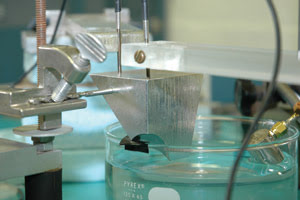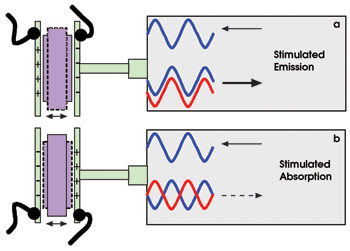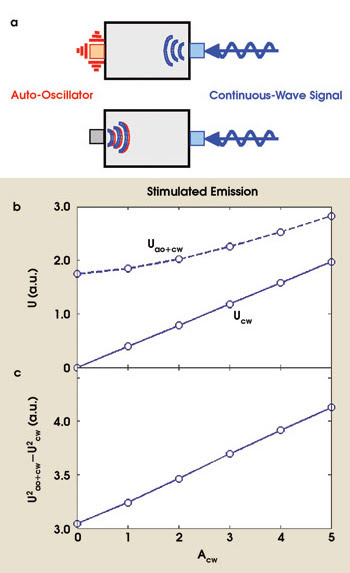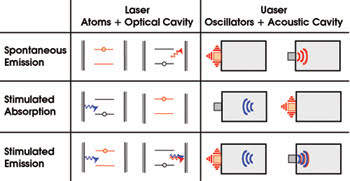The uaser (pronounced WAY-zer), which produces coherent ultrasonic waves, could be used to study lasers and to detect subtle changes in modern materials.
Alexey G. Yamilov, University of Missouri-Rolla, and Richard L. Weaver and Oleg I. Lobkis, University of Illinois at Urbana-Champaign
In his seminal paper1, Albert Einstein introduced the concept of stimulated emission of electromagnetic radiation that led to the invention of masers and lasers. Ever since, there has been a propensity to regard stimulated and spontaneous emission as quantum-mechanical effects. However, these concepts have clear classical (nonquantum) analogues that we demonstrate in experiments with ultrasound.
We have designed an electromechanical system consisting of ultrasonic oscillators that emit both spontaneously and by stimulated emission like atoms in an optical laser. The set of nominally independent oscillators lock to each other and produce a high-intensity coherent field. In the absence of stimulated emission, they produce a weak and incoherent field.
Classical lasers have pedagogic value and potential in laser research. We anticipate that ultrasonic analogues (uasers), with their longer wavelengths and convenient frequencies, will allow experiments not possible with optical lasers. The high sensitivity of the spectrally narrow uasing line to perturbations makes the uaser suitable for precision sensing measurements in acoustics.
To design an acoustic analogue of a laser requires analogues of the two essential components of a laser: the optical resonator to confine the light and the gain medium to amplify the light. Making the former for an acoustic device is trivial — any chunk of metal will do. Ultrasound waves bounce off the boundaries of the metal block much like light bounces between mirrors in a laser resonator. We used acoustical resonators of various sizes and shapes. An example is seen in Figure 1.

Figure 1. Two piezoelectric transducers (top center) are attached to an aluminum block (center) that serves as a resonator — an acoustical cavity. The transducers emit and absorb acoustic waves similar to the way atoms emit and absorb electromagnetic waves. Courtesy of James Phillips.
Electromechanical ‘atoms’
Realizing a gain medium was the chief challenge. Stimulated emission (“se” in the laser acronym) encompasses two properties: The emitted radiation has the same frequency and the same phase as the incident wave. Quantum mechanical properties of atoms ensure that both conditions are met in lasers.2
To emulate stimulated emission of ultrasound waves, we constructed an electronic-circuit auto-oscillator, which is simply an RL circuit (with negative resistance [R]). At some resonant frequency determined by the circuit parameters, the voltage tends to oscillate in a way that is similar to the oscillation of the charge distribution in an atom at its transition frequency.
When one inserts a piece of piezoelectric material into the capacitor, the oscillating voltage across the capacitor plates causes the material to deform. The deformation can be translated into real vibrations. The device that operates according to this principle is called a piezoelectric transducer: It converts mechanical vibrations into voltage oscillations and back (Figure 2).

Figure 2. Oscillating voltage across the capacitor plates induces vibration of piezoelectric material that is transferred to the cavity in the form of acoustic waves. When appropriately designed, the oscillator tends to synchronize (acquires the same frequency) with the acoustic waves inside cavity. Depending on the phase of the produced acoustic field (red), it would correspond to stimulated emission (a) or absorption (b).
In other words, the electronic circuit auto-oscillator (the electromechanical “atom”) interacts with the reverberating acoustic cavity via the piezoelectric transducer, which can emit and absorb acoustic waves. This is similar to the way an atom interacts with an optical resonator through emission and absorption of the electromagnetic waves.
To demonstrate that our artificial atoms are capable of stimulated emission, we attached a second transducer to another point on the cavity (Figure 3a). After we applied a CW signal of sufficient amplitude (Acw) to the transducer, we observed entrainment: The atom adjusted its frequency to match that of the incident acoustic wave produced by the CW signal, and the phase between the two became fixed. Theoretical analyses suggest that this process can result in additional absorption or emission, depending on the phase difference between the CW source and the auto-oscillator (Figure 2).
We distinguished stimulated emission and absorption with the following measurement. The frequency of the CW source is chosen to coincide with that of the auto-oscillator, and its amplitude (Acw) is gradually increased. Figure 3b shows the vibration amplitude of the cavity as a function of Acw with (Uao+cw) and without (Ucw) the auto-oscillator as a function of Acw.
If there is no particular relationship (no phase locking) between phases of Acw and Aao, the term U2ao+cw – U2cw should equal U2ao. In contrast, the linear dependence of U2ao+cw – U2cw on Acw clearly shows the presence of the interference term AaoA*cw + AcwA*ao (Figure 3c). The linear dependence can have positive signs (stimulated emission, shown in Figure 3c) and negative (stimulated absorption), depending on the frequency and position of the transducers.

Figure 3. An experiment was conducted with stimulated emission of ultrasound. In a, the transducer on the right generates a continuous acoustic wave that is incident on the auto-oscillator’s transducer and stimulates emission (or absorption) of ultrasound. The energy of the auto-oscillator amplifies the impinging wave via stimulated emission as seen in Figure 2a. The energy in the auto-oscillator is replenished by external means (uaser counterpart of pumping in lasers). Panel b plots the amplitude (U) of the vibration of the acoustic cavity with (dashed line) and without (solid line) the auto-oscillator signal. In c, the linear dependence of U2ao+cw – U2cw on Acw indicates the presence of an interference term between the incident and emitted acoustic wave. The positive slope means that it is stimulated emission (the slope would be negative for absorption).
This experiment shows that frequency locking indeed entails phase locking as well and that, if the phase is right, the stimulated emission of acoustic waves is realized.
Quantum versus classical
Conventional lasers employ quantum-mechanical oscillators with quantized energy levels, and, therefore, Planck’s constant appears in expressions for optical gain. However, an unusual type of laser, the free-electron laser, does not rely on the quantum transitions to provide stimulated emission. Its gain coefficient does not contain Planck’s constant, and a classical description is sufficient.3 The required phase synchronization of the classical oscillators (electrons in magnetic field) becomes possible because of a bunching effect in which electrons group into locations where their phase corresponds to stimulated emission (recall Figure 2).
Sergei T. Zavtrak proposed a clever acoustical analogue of the free-electron laser.4 Oscillation of the size of air bubbles in a dielectric liquid can be induced by electrostriction. Each bubble becomes a localized source of acoustic radiation — a speaker. Interaction with a standing acoustic wave creates a force that drives the bubbles into the antinode regions, enabling the necessary synchronization. This type of acoustical “laser” has never been built.
We should note that the term saser (the first “s” stands for sound) has been coined for a phonon laser.5 Unlike our purely classical experiment, the stimulated emission in sasers is achieved with population inversion in a multilevel quantum system. The synchronization of the frequency and the phase of the electromechanical oscillators is a complex phenomenon that occurs because of nonlinearities in the electronic circuits.
Figure 4 shows how three fundamental processes by which our auto-oscillators interact with ultrasonic waves in uaser directly correspond to atom-electromagnetic field interactions in lasers.

Figure 4. Emission and absorption of ultrasound by an oscillator is analogous to emission and absorption of light by an atom.
Spontaneous emission: A transducer (red square) generates an acoustic wave when brought in contact with a quiet (void of vibrations) cavity. The frequency and phase of the emitted acoustic wave depend on the auto-oscillator properties and on the location of the transducer (an acoustic version of the Purcell effect in optics). Internal energy of the auto-oscillator is used up to produce the ultrasound wave in a way that is similar to spontaneous emission of a photon by an excited atom.
But unlike the spontaneous emission of a photon from a single atom, spontaneous emission of ultrasound from a single auto-oscillator is a continuous process. Electrical energy supplied to the auto-oscillator is continuously transformed (with some losses) into ultrasound. A set of many continuously pumped, spontaneously emitting atoms produces a continuous incoherent optical field; analogously, a set of spontaneously emitting auto-oscillators produces a continuous incoherent ultrasonic field.
Stimulated absorption: An incident acoustic wave with the frequency sufficiently close to that of the auto-oscillator causes the oscillator to lock its frequency and phase. The locking phase corresponds to absorption (as in Figure 2b). Acoustic energy is transferred from the acoustic wave to the auto-oscillator circuit, in a manner similar to the excitation of an internal state of an atom.
Stimulated emission: It is the same as in stimulated absorption, but the locking phase corresponds to emission (as in Figure 2a). The energy needed to amplify the incident acoustic wave is drawn from the auto-oscillator, similar to the stimulated de-excitation of an atom.
Note that, for spontaneous emission (Figure 4, top right), the phase and frequency of the emitted wave are determined by the auto-oscillator and its position, without outside influence. In the case of stimulated emission (bottom right), the phase and frequency of the emitted (red) wave are prescribed by the incident (blue) wave.
The above demonstrates that our nonlinear classical oscillator can emit acoustic waves spontaneously and by stimulation. Further experiments showed that a set of independent auto-oscillators also generates a coherent single-frequency acoustic state that is correlated throughout the cavity. These observations justify the acronym uaser. We see several areas where it may find application.
Uaser: What is it good for?
Passive (no amplification) acoustic wave experiments have allowed study of the wave functions of quantum dots and chaotic optical resonators. Designing an acoustical analogue of an optical laser would provide the ability to experiment with stimulated emission (amplification) of ultrasound and to monitor uasing states of the acoustic cavity. This could prove useful in research on lasing in complex media — random,6 chaotic7 and photonic crystal lasers — where similar direct optical measurements are challenging.
Extreme sensitivity of the uaser frequency to the physical parameters of the cavity may lead to sensing and monitoring applications. We detected a shift of the uasing frequency in response to a drop of water 105 times smaller than the mass of cavity, and our estimates show that the actual accuracy is much higher — perhaps as much as 108. This level of precision would allow monitoring of cracks and their evolution, of chemical curing and other processes resulting in changes in elastic constants, and/or of the local mass density of the acoustic cavity.
Finally, the phenomenon of locking coupled auto-oscillators is an interesting problem in its own right. It is related to studies of the synchronization of ensembles of auto-oscillators that describe the dynamics of physical, biological and social systems.8
Acknowledgments
A.Y. acknowledges support from the University of Missouri-Rolla. R.W and O.L. acknowledge the support of the NSF Dynamic Systems and Controls Program through grant number CMS OS-28096.
Meet the authors
Alexey G. Yamilov is research assistant professor of physics at the University of Missouri-Rolla; e-mail: [email protected].
Richard L. Weaver is professor of theoretical and applied mechanics and physics at the University of Illinois at Urbana-Champaign; e-mail: [email protected].
Oleg I. Lobkis is research associate in the department of theoretical and applied mechanics at the University of Illinois at Urbana-Champaign; e-mail: [email protected].
References
1. A. Einstein (1917). Zur Quantentheorie der Strahlen. PHYSIKA ZEITSCHRIFT, Vol. 18, p. 121.
2. M. Sargent et al (1974). Laser Physics. Addison-Wesley, London.
3. C. Pellegrini and S. Reiche (2003). Free-Electron Lasers in The Optics Encyclopedia: Basic Foundations and Practical Applications. Wiley-VCH, Berlin.
4. S.T. Zavtrak and I.V. Volkov (1997). Saser (Sound Amplification by Stimulated Emission of Radiation). TECH PHYS, Vol. 42, p. 406.
5. L. Challis and S. Clough (1994). Population inversion in the SASER. NATURE, Vol. 367, pp. 687-688.
6. H. Cao (2005). Random Lasers: Development, Features and Applications. OPT PHOTON NEWS, Vol. 16, p. 24.
7. A.D. Stone (2005). Einstein’s Unknown Insight and the Problem of Quantizing Chaos, PHYS TODAY, Vol. 58, p. 37.
8. A. Pikovsky et al (2001). Synchronization: A universal concept in nonlinear sciences. Cambridge University Press, Cambridge.